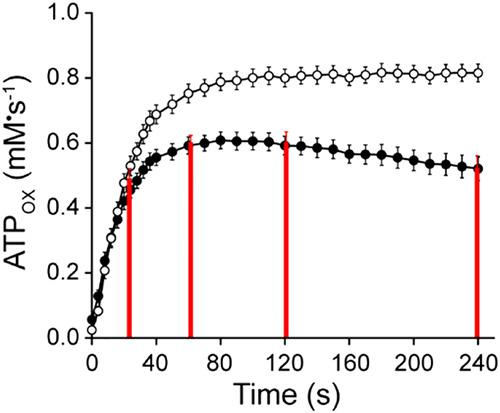当前位置:
X-MOL 学术
›
NMR Biomed.
›
论文详情
Our official English website, www.x-mol.net, welcomes your
feedback! (Note: you will need to create a separate account there.)
Validity and accuracy of calculating oxidative ATP synthesis in vivo during high-intensity skeletal muscle contractions.
NMR in Biomedicine ( IF 2.7 ) Pub Date : 2020-08-16 , DOI: 10.1002/nbm.4381 Miles F Bartlett 1 , Liam F Fitzgerald 1 , Rajakumar Nagarajan 2 , Jane A Kent 1
NMR in Biomedicine ( IF 2.7 ) Pub Date : 2020-08-16 , DOI: 10.1002/nbm.4381 Miles F Bartlett 1 , Liam F Fitzgerald 1 , Rajakumar Nagarajan 2 , Jane A Kent 1
Affiliation

|
Several methods have been developed for using 31P‐MRS to calculate rates of oxidative ATP synthesis (ATPOX) during muscular contractions based on assumptions that (1) the ATP cost of force generation (ATPCOST) remains constant or (2) Michaelis‐Menten coupling between cytosolic ADP and ATPOX does not change. However, growing evidence suggests that one, or both, of these assumptions are invalid during high‐intensity fatigue protocols. Consequently, there is a need to examine the validity and accuracy of traditional ATPOX calculation methods under these conditions. To address this gap, we measured phosphate concentrations and pH in the vastus lateralis muscle of nine young adults during four rest‐contraction‐recovery trials lasting 24, 60, 120, and 240 s. The initial velocity of phosphocreatine resynthesis (ViPCr) following each trial served as the criterion measure of ATPOX because this method makes no assumptions of constant ATPCOST or Michaelis‐Menten coupling between changes in cytosolic ADP and ATPOX. Subsequently, we calculated ATPOX throughout the 240 s trial using several traditional calculation methods and compared estimations of ATPOX from each method with time‐matched measurements of ViPCr. Method 1, which assumes that ATPCOST does not change, was able to model changes in ViPCr over time, but showed poor accuracy for predicting ViPCr across a wide range of ATPOX values. In contrast, Michaelis‐Menten methods, which assume that the relationship between changes in cytosolic ADP and ATPOX remains constant, were invalid because they could not model the decline in ViPCr. However, adjusting these Michaelis‐Menten methods for observed changes in maximal ATPOX capacity (i.e., Vmax) permitted modeling of the decline in ViPCr and markedly improved accuracy. The results of these comprehensive analyses demonstrate that valid, accurate measurements of ATPOX can be obtained during high‐intensity contractions by adjusting Michaelis‐Menten ATPOX calculations for changes in Vmax observed from baseline to post‐fatigue.
中文翻译:

在高强度骨骼肌收缩期间计算体内氧化 ATP 合成的有效性和准确性。
已经开发了几种使用31 P-MRS 计算肌肉收缩期间氧化 ATP 合成速率 (ATP OX ) 的方法,基于以下假设:(1) ATP 力量生成成本(ATP COST ) 保持不变或 (2) Michaelis-胞质 ADP 和 ATP OX之间的 Menten 偶联不会改变。然而,越来越多的证据表明,在高强度疲劳方案中,这些假设中的一个或两个是无效的。因此,有必要检查传统 ATP OX的有效性和准确性这些条件下的计算方法。为了弥补这一差距,我们在持续 24、60、120 和 240 秒的四项休息-收缩-恢复试验中测量了 9 名年轻人股外侧肌的磷酸盐浓度和 pH。每次试验后磷酸肌酸再合成的初始速度 ( V iPCr ) 作为 ATP OX的标准度量,因为该方法没有假设恒定的 ATP COST或细胞溶质 ADP 和 ATP OX变化之间的 Michaelis-Menten 耦合。随后,我们计算ATP OX ATP的整个使用几种传统计算方法240秒试验并比较估计OX从每个方法与V iPCr 的时间匹配测量。假设 ATP COST不变的方法 1能够模拟V iPCr随时间的变化,但在广泛的 ATP OX值范围内预测V iPCr 的准确性较差。相比之下,Michaelis-Menten 方法假设细胞溶质 ADP 和 ATP OX变化之间的关系保持不变,则无效,因为它们无法模拟V iPCr的下降。然而,这些调整对于在最大ATP观察到的变化米氏方法OX容量(即,V最大) 允许对V iPCr的下降进行建模并显着提高准确性。这些综合分析的结果表明,通过调整 Michaelis-Menten ATP OX计算以适应从基线到疲劳后观察到的V max变化,可以在高强度收缩期间获得有效、准确的 ATP OX测量值。
更新日期:2020-10-05
中文翻译:

在高强度骨骼肌收缩期间计算体内氧化 ATP 合成的有效性和准确性。
已经开发了几种使用31 P-MRS 计算肌肉收缩期间氧化 ATP 合成速率 (ATP OX ) 的方法,基于以下假设:(1) ATP 力量生成成本(ATP COST ) 保持不变或 (2) Michaelis-胞质 ADP 和 ATP OX之间的 Menten 偶联不会改变。然而,越来越多的证据表明,在高强度疲劳方案中,这些假设中的一个或两个是无效的。因此,有必要检查传统 ATP OX的有效性和准确性这些条件下的计算方法。为了弥补这一差距,我们在持续 24、60、120 和 240 秒的四项休息-收缩-恢复试验中测量了 9 名年轻人股外侧肌的磷酸盐浓度和 pH。每次试验后磷酸肌酸再合成的初始速度 ( V iPCr ) 作为 ATP OX的标准度量,因为该方法没有假设恒定的 ATP COST或细胞溶质 ADP 和 ATP OX变化之间的 Michaelis-Menten 耦合。随后,我们计算ATP OX ATP的整个使用几种传统计算方法240秒试验并比较估计OX从每个方法与V iPCr 的时间匹配测量。假设 ATP COST不变的方法 1能够模拟V iPCr随时间的变化,但在广泛的 ATP OX值范围内预测V iPCr 的准确性较差。相比之下,Michaelis-Menten 方法假设细胞溶质 ADP 和 ATP OX变化之间的关系保持不变,则无效,因为它们无法模拟V iPCr的下降。然而,这些调整对于在最大ATP观察到的变化米氏方法OX容量(即,V最大) 允许对V iPCr的下降进行建模并显着提高准确性。这些综合分析的结果表明,通过调整 Michaelis-Menten ATP OX计算以适应从基线到疲劳后观察到的V max变化,可以在高强度收缩期间获得有效、准确的 ATP OX测量值。











































 京公网安备 11010802027423号
京公网安备 11010802027423号